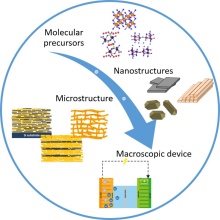The motivation for our research is the need for better batteries, which is driven by the rapid developments in the fields of mobility and sustainable energy storage, which require a high power density, fast charging rate and long lifetime of more than several years. To overcome these limitations, intense research is directed to either finding strategies to further improve metal ion batteries or to develop alternative types of batteries. While most battery research has been focused on improving the electrode chemistry, the optimization of the electrode structure on the micro- and nanoscale is even more important. The latter task requires nanostructuring and aligning of the different components, for which the combination of material design and electrochemical engineering is essential.
The input of material science is transferring the structural concepts of biomaterials into the electrodes, resulting in self-supporting and binder-free electrodes (unlike conventional electrodes) in the form of micrometer thick flexible paper. Such papers exhibit a high mechanical flexibility, as illustrated in the video:
The envisioned electrodes comprise an alternating layer architecture combining inorganic nanostructures (i.e., SnO2 nanowires, V2O5 nanofibres, or LiMnPO4 nanoplatelets) as metal ion storage units with graphene sheets as charge transport elements of high mechanical flexibility and chemical stability. While the alternating layer structure is devised to facilitate stress distribution between the two types of constituents, the good electrical conductivity of the graphene is ideally suited to enhance the charge-discharge kinetics.
The major task is to explore the mechanical and electrochemical performance of the electrodes. Further the ratio between the inorganic and graphene layers, the microstructure and morphology of these layers, as well as the interfacial coupling between them. Our novel, paper-like electrodes are promising for different metal ion battery, where high energy density, rate capability and cycling stability is aimed.
- Z. Burghard, A. Leinweber, P. A. van Aken, T. Dufaux, M. Burghard and Joachim Bill, Hydrogen-Bond Reinforced Vanadia Nanofiber Paper of High Stiffnes, Advanced Materials, 25, 2013.
- B. Wicklein, A. M. Diem, A. Knöller, M. S. Cavalcante, L. Bergström, J. Bill and Z. Burghard, Dual-Fiber Approach toward Flexible Multifunctional Hybrid Materials, Advanced Functional Materials, 28, 2017.
- A. Knöller, C. P. Lampa, F. von Cube, T. H. Zeng, D. C. Bell, M. S. Dresselhaus, Z. Burghard and J. Bill, Strengthening of Ceramic-based Artificial Nacre via Synergistic Interactions of 1D Vanadium Pentoxide and 2D Graphene Oxide Building Blocks, Scientific Reports, 7, 2017.
- A. M. Diem, A. Knöller, Z. Burghard and J. Bill, Free-Standing Nanostructured Vanadium Pentoxide Films for Metal-Ion Batteries, Nanoscale, 10, 2018.
- T. Jahnke, A. Knöller, S. Kilper, D. Rothenstein, M. Widenmeyer, Z. Burghard and J. Bill, Coalescence in Hybrid Materials: The Key to High-Capacity Electrodes, ACS Applied Energy Materials, 1, 2018.
Porous scaffolds inspired by cuttlebone
There is an increasing interest in light weight, functional materials that are suitable for applications related to sensors, filtering, gas distribution, acoustic and thermal insulators, catalysts or energy storage and conversion. In this work, the architecture of cuttlebone, a high performance structural biomaterial, shall be fully implemented into a synthetic, single-component, ceramic-based scaffold that combines a high specific surface area with high flexibility and good mechanical stability. This task is reached by an approach involving ice-templating of aqueous suspensions. The basic idea is to obtain a porosity that is a replica of the ice crystals, by freezing suspension and subsequently removing the ice crystals by sublimation.
Using the ice-templating approach we succeeded in producing V2O5 based scaffolds with millimeter dimensions and an extremely high porosity of 99.8%. Their microstructure is characterized by a highly ordered structure composed of stacked lamellas. Furthermore, the scaffolds deform under compression in an unusual manner for a ceramic material, as illustrated the two videos. Instead of brittle crushing, the scaffold walls elastically buckle. This behaviour is due not only to the intricate architecture, but also to the high flexibility of the nanofibers, as can be seen from their capability to bend without breaking.
- A. Knöller, T. Runčevski, R. E. Dinnebier, J. Bill and Z. Burghard, Cuttelbone-like V2O5 Nanofibre Scaffolds – Advances in Strucutring Cellular Solids, Scientific Reports, 7, 2017.
- A. Knöller, S. Kilper, A. M. Diem, M. Widenmeyer, T. Runčevski, R. E. Dinnebier, J. Bill and Z. Burghard, Ultrahigh Damping Capacities in Lighwight Structural Materials, Nano Letter, 18, 2018.
- Deutschlandfunk 2013: Keramik zum Falten
- Deutschlandfunk 2018: Tintenfische liefern Blaupause für Leichtbau-Werkstoff
- Uni Webpage 2018: Den Geheimnissen der Biosynthese auf die Spur kommen
Kontakt

Zaklina Burghard
Dr.Group leader





